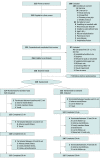Effect of Timing and Coordination Training on Mobility and Physical Activity Among Community-Dwelling Older Adults: A Randomized Clinical Trial
- PMID: 35604689
- PMCID: PMC9127558
- DOI: 10.1001/jamanetworkopen.2022.12921
Effect of Timing and Coordination Training on Mobility and Physical Activity Among Community-Dwelling Older Adults: A Randomized Clinical Trial
Abstract
Importance: Standard exercise interventions targeting underlying physiologic system impairments have limited success in improving walking. Augmenting standard interventions with timing and coordination training, which incorporates the principles of motor learning and integrates multiple systems, may be more successful.
Objective: To determine whether a standard strength and endurance program incorporating timing and coordination training (standard-plus) improves gait speed more than strength and endurance training alone.
Design, setting, and participants: The Program to Improve Mobility in Aging (PRIMA) study was an assessor-blinded, randomized, 2-group intervention trial that included a 12-week intervention and 24-week follow-up period. The trial was conducted at a university research clinic from 2016 to 2020. Participants included 249 community-dwelling older adults (aged ≥65 years) with gait speed between 0.60 and 1.20 m/s. Statistical analysis was performed from December 2020 to March 2021.
Interventions: Participants were randomized to standard strength and endurance (n = 125) or standard-plus, including timing and coordination training (n = 124), 50 to 60 minutes, twice a week for 12 weeks.
Main outcomes and measures: Primary outcome of gait speed and secondary outcomes representing components of the intervention (leg strength and power, 6-minute walk test, chair sit-and-reach test, and figure of 8 walk test) and activity and participation (Late Life Function and Disability Instrument and daily physical activity measured by accelerometry) were measured at 12, 24, and 36 weeks.
Results: Among 249 randomized participants, 163 (65.5%) were female, 22 (8.8%) were Black, 219 (88.0%) were White; mean (SD) age was 77.4 (6.6) years; mean (SD) gait speed was 1.07 (0.16) m/s; and 244 (98.0%) completed the intervention. The 2 groups did not have significantly different improvements in gait speed or secondary outcomes representing the components of the intervention at any time point. For gait speed, individuals in the standard-plus group had a mean (SD) improvement of 0.079 (0.135) m/s over 12 weeks, 0.065 m/s (0.141) over 24 weeks, and 0.059 (0.150) m/s over 36 weeks; individuals in the standard group improved gait speed by 0.081 (0.124) m/s over 12 weeks, 0.051 (0.129) m/s over 24 weeks, and 0.065 (0.148) m/s over 36 weeks.
Conclusions and relevance: This randomized clinical trial found no difference in gait speed change between the standard and standard-plus intervention groups, and both groups showed sustained improvements in mobility 24 weeks after the intervention.
Trial registration: ClinicalTrials.gov Identifier: NCT02663778.
Conflict of interest statement
Figures
Comment in
-
Critically appraised paper: Timing and coordination training does not enhance standard treatment benefit on mobility in community-dwelling older adults.J Physiother. 2023 Apr;69(2):125. doi: 10.1016/j.jphys.2023.02.004. Epub 2023 Mar 10. J Physiother. 2023. PMID: 36907807 No abstract available.
-
Critically appraised paper: Timing and coordination training does not enhance standard treatment benefit on mobility in community-dwelling older adults [commentary].J Physiother. 2023 Apr;69(2):125. doi: 10.1016/j.jphys.2023.02.003. Epub 2023 Mar 15. J Physiother. 2023. PMID: 36925379 No abstract available.
Similar articles
-
Effectiveness of a Timing and Coordination Group Exercise Program to Improve Mobility in Community-Dwelling Older Adults: A Randomized Clinical Trial.JAMA Intern Med. 2017 Oct 1;177(10):1437-1444. doi: 10.1001/jamainternmed.2017.3609. JAMA Intern Med. 2017. PMID: 28806436 Free PMC article.
-
Comparing Two Types of Exercise Classes to Help Older Adults Improve Walking Ability [Internet].Washington (DC): Patient-Centered Outcomes Research Institute (PCORI); 2018 Mar. Washington (DC): Patient-Centered Outcomes Research Institute (PCORI); 2018 Mar. PMID: 36924509 Free Books & Documents. Review.
-
Program to improve mobility in aging (PRIMA) study: Methods and rationale of a task-oriented motor learning exercise program.Contemp Clin Trials. 2020 Feb;89:105912. doi: 10.1016/j.cct.2019.105912. Epub 2019 Dec 12. Contemp Clin Trials. 2020. PMID: 31838258 Free PMC article.
-
Impact of exercise to improve gait efficiency on activity and participation in older adults with mobility limitations: a randomized controlled trial.Phys Ther. 2011 Dec;91(12):1740-51. doi: 10.2522/ptj.20100391. Epub 2011 Oct 14. Phys Ther. 2011. PMID: 22003158 Free PMC article. Clinical Trial.
-
Effectiveness of exercise interventions on physical function in community-dwelling frail older people: an umbrella review of systematic reviews.JBI Database System Rev Implement Rep. 2018 Mar;16(3):752-775. doi: 10.11124/JBISRIR-2017-003551. JBI Database System Rev Implement Rep. 2018. PMID: 29521871
Cited by
-
The Impact of Executive Function on Retention and Compliance in Physical Therapy in Veterans.Arch Rehabil Res Clin Transl. 2024 Nov 5;6(4):100383. doi: 10.1016/j.arrct.2024.100383. eCollection 2024 Dec. Arch Rehabil Res Clin Transl. 2024. PMID: 39822209 Free PMC article.
-
Retracted: Evaluating the Clinical Efficacy of an Exergame-Based Training Program for Enhancing Physical and Cognitive Functions in Older Adults With Mild Cognitive Impairment and Dementia Residing in Rural Long-Term Care Facilities: Randomized Controlled Trial.J Med Internet Res. 2025 Feb 19;27:e69109. doi: 10.2196/69109. J Med Internet Res. 2025. Retraction in: J Med Internet Res. 2025 May 23;27:e77638. doi: 10.2196/77638. PMID: 39969990 Free PMC article. Retracted. Clinical Trial.
-
Interventions to improve outdoor mobility among people living with disabilities: A systematic review.Campbell Syst Rev. 2024 Jun 14;20(2):e1407. doi: 10.1002/cl2.1407. eCollection 2024 Jun. Campbell Syst Rev. 2024. PMID: 38882933 Free PMC article. Review.
-
The Impact of a 12-Week Aqua Fitness Program on the Physical Fitness of Women over 60 Years of Age.Sports (Basel). 2024 Apr 11;12(4):105. doi: 10.3390/sports12040105. Sports (Basel). 2024. PMID: 38668573 Free PMC article.
-
Effects of a Physical Therapist Intervention on GPS Indicators of Community Mobility in Older Adults: A Secondary Analysis of a Randomized Controlled Trial.Phys Ther. 2023 Aug 1;103(8):pzad071. doi: 10.1093/ptj/pzad071. Phys Ther. 2023. PMID: 37364044 Free PMC article. Clinical Trial.


